Imagine a small bird with striking black and orange feathers. This colorful bird is not just pretty to look at; it’s also full of life and energy. The black and orange bird stands out in nature with its bright colors, making it easy to spot among the trees. Whether you see it in your backyard or in the wild, this bird is sure to catch your eye with its vibrant appearance and cheerful song.
10 Stunning Black and Orange Birds
| No. | Bird Name | Description |
|---|---|---|
| 1 | Baltimore Oriole | Bright orange with black wings. |
| 2 | Blackburnian Warbler | Orange throat with black and white body. |
| 3 | American Redstart | Black with orange patches on wings and tail. |
| 4 | Scarlet Tanager (Male) | Mostly black with bright orange-red body. |
| 5 | Spotted Towhee | Black body with orange sides and white belly. |
| 6 | Varied Thrush | Orange belly with black wings and head. |
| 7 | Eastern Towhee | Black with orange sides and white belly. |
| 8 | Western Tanager | Bright orange head with black wings and back. |
| 9 | Orchard Oriole (Male) | Dark orange with black head and back. |
| 10 | Hooded Oriole | Bright orange body with black wings and head. |
10 Black and Orange Birds
Birds with black and orange feathers are some of nature’s most vibrant creatures. Their bold colors are not only beautiful but also serve important roles in their lives, from attracting mates to camouflage. In this detailed guide, we’ll explore ten black and orange birds, diving into their appearance, habitats, behaviors, and much more. Whether you’re a seasoned birdwatcher or a curious beginner, this article will offer you a closer look at these stunning birds in a way that’s easy to understand.
1. Baltimore Oriole
Appearance:
The Baltimore Oriole is a small to medium-sized bird, around 7 to 8 inches in length. The male Baltimore Oriole is particularly striking with its bright orange body, contrasted by its black head, wings, and tail. The female is typically duller, with a yellow-orange body and grayish wings.
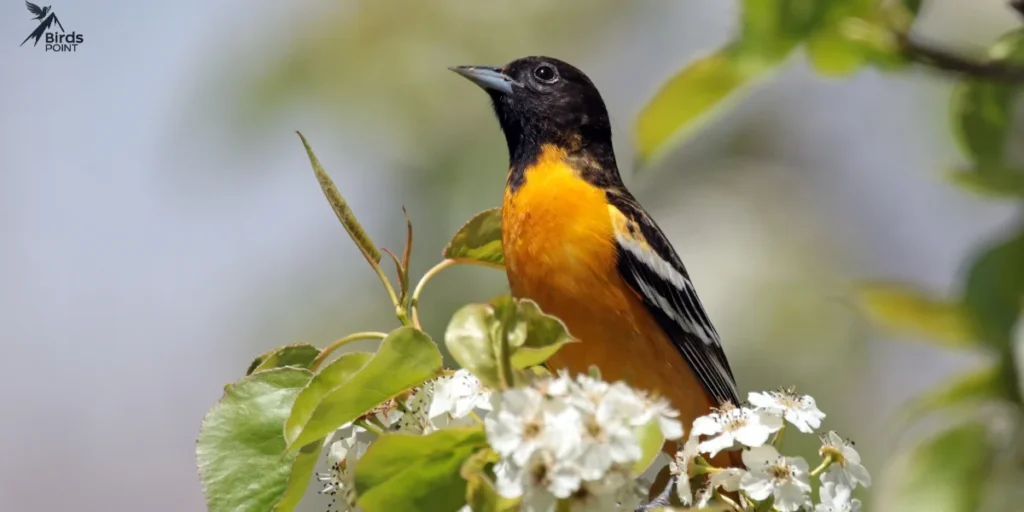
Habitat:
Baltimore Orioles are commonly found across the eastern and central United States during the breeding season. They prefer open woodlands, edges of forests, gardens, and even urban parks. Orioles are known for their woven, hanging nests, which they build in the high branches of trees.
Diet:
These birds are omnivores, with a diet that includes insects, fruits, and nectar. Insects like caterpillars, beetles, and spiders are crucial during the breeding season when they need extra protein. Orioles are also famous for their love of sweet fruits, especially oranges and berries, which many people use to attract them to their yards.
Behavior and Migration:
Baltimore Orioles are migratory birds, spending the winter in Central America and northern South America. Their migration is a long and perilous journey, and they are often seen feeding heavily before they embark on their southward journey. Orioles are also known for their beautiful, flutelike song, which males use to establish territories and attract mates.
Conservation Status:
Currently, Baltimore Orioles are not considered endangered, but like many birds, they face threats from habitat loss and pesticide use. Conservation efforts focus on preserving their natural habitats and reducing pesticide use in agriculture.
Cultural Significance:
The Baltimore Oriole is the state bird of Maryland, a nod to the orange and black colors of the coat of arms of Lord Baltimore, the state’s founder. Orioles are also popular in folklore and literature, often symbolizing joy and beauty.
Interesting Fact:
The intricate nest of the Baltimore Oriole, which hangs like a basket from tree branches, is an engineering marvel. Female orioles spend about a week weaving these nests, using plant fibers, grass, and sometimes even bits of string or yarn.
| Feature | Details |
|---|---|
| Scientific Name | Icterus galbula |
| Lifespan | 6 to 12 years |
| Size | 7 to 8 inches (17.8 to 20.3 cm) |
| Wingspan | 11.5 to 12.5 inches (29 to 32 cm) |
| Weight | 1.1 to 1.4 ounces (30 to 40 grams) |
2. Blackburnian Warbler
Appearance:
The Blackburnian Warbler is a small, brightly colored bird that measures around 4.5 to 5 inches in length. The male, especially during the breeding season, is easily recognized by its bright orange throat and face, contrasted by its black and white body. Females and immature birds are more subdued in color, with a yellowish-orange throat and olive-brown upper parts.
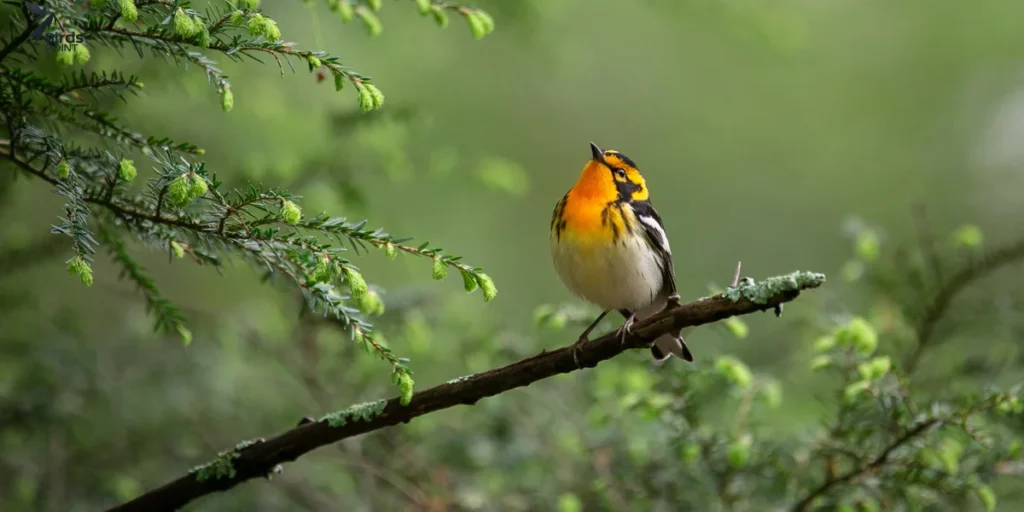
Habitat:
Blackburnian Warblers are primarily found in the eastern United States and parts of Canada. They inhabit mature forests, particularly those with a mix of coniferous and deciduous trees. During migration, they can also be found in gardens, parks, and shrubby areas.
Diet:
These warblers are insectivorous, feeding primarily on caterpillars, moths, beetles, and spiders. During migration, they may also consume small fruits and berries to supplement their diet. They are active foragers, often seen flitting about in the treetops in search of food.
Behavior and Migration:
The Blackburnian Warbler is a long-distance migrant, traveling from North America to its wintering grounds in South America, including the Andes and northern Amazon Basin. This migration is one of the longest for any warbler, and they depend on stopover habitats to rest and refuel during their journey. Males are known for their high-pitched, buzzy songs, which are a common sound in their breeding territories.
Conservation Status:
The Blackburnian Warbler is currently listed as Least Concern, but it faces threats from habitat loss, particularly in its breeding and wintering grounds. Conservation efforts include protecting large tracts of forest and promoting sustainable forestry practices.
Cultural Significance:
While not as well-known as some other warblers, the Blackburnian Warbler is a favorite among birdwatchers due to its striking appearance. Its vivid colors and lively behavior make it a highlight during birding events, especially during migration seasons.
Interesting Fact:
The Blackburnian Warbler was named after Anna Blackburne, an English naturalist in the 18th century. It was one of the first birds described from the New World to be named after a woman.
| Feature | Details |
|---|---|
| Scientific Name | Setophaga fusca |
| Lifespan | Up to 10 years |
| Size | 4.5 to 5 inches (11.5 to 13 cm) |
| Wingspan | 7.9 to 8.7 inches (20 to 22 cm) |
| Weight | 0.3 to 0.4 ounces (8 to 12 grams) |
3. American Redstart
Appearance:
The American Redstart is a small, energetic bird, typically measuring 4.3 to 5.5 inches in length. The male is predominantly black with bright orange patches on its wings, sides, and tail. Females and young males are more subdued in color, featuring grayish or olive upper parts with yellow patches instead of orange.

Habitat:
American Redstarts are found across a wide range of North America during the breeding season, from Canada to the southern United States. They prefer deciduous forests, particularly those near water. During migration, they can be found in a variety of habitats, including gardens and urban areas.
Diet:
The American Redstart is primarily insectivorous, feeding on a wide variety of insects, including flies, beetles, and moths. They are known for their unique method of hunting, where they spread their tails and wings to flash their bright colors, startling insects into flight, making them easier to catch.
Behavior and Migration:
American Redstarts are known for their acrobatic flight and constant movement, often flitting from branch to branch in search of food. They are migratory birds, wintering in Central and South America, particularly in moist tropical forests. Their migration is characterized by a series of short hops, stopping frequently to feed along the way.
Conservation Status:
The American Redstart is currently listed as Least Concern, with stable populations across its range. However, like many migratory birds, it faces threats from habitat loss and climate change. Conservation efforts include preserving both breeding and wintering habitats.
Cultural Significance:
The American Redstart is often referred to as the “butterfly of the bird world” due to its vibrant colors and flitting flight pattern. It is a popular species among birdwatchers, especially during the spring and fall migrations when they are more visible.
Interesting Fact:
The American Redstart is one of the few warblers that can successfully rear two broods in a single breeding season, thanks to its early arrival in spring and the availability of abundant food sources.
| Feature | Details |
|---|---|
| Scientific Name | Setophaga ruticilla |
| Lifespan | 5 to 10 years |
| Size | 4.3 to 5.5 inches (11 to 14 cm) |
| Wingspan | 6.3 to 7.5 inches (16 to 19 cm) |
| Weight | 0.2 to 0.3 ounces (6 to 9 grams) |
4. Scarlet Tanager (Male)
Appearance:
The male Scarlet Tanager is one of the most striking birds in North America, with its bright red-orange body and contrasting black wings and tail. The female is much less colorful, with olive-yellow upper parts and pale yellow underparts. The males only display their vibrant colors during the breeding season, after which they molt into a duller, olive-green plumage.
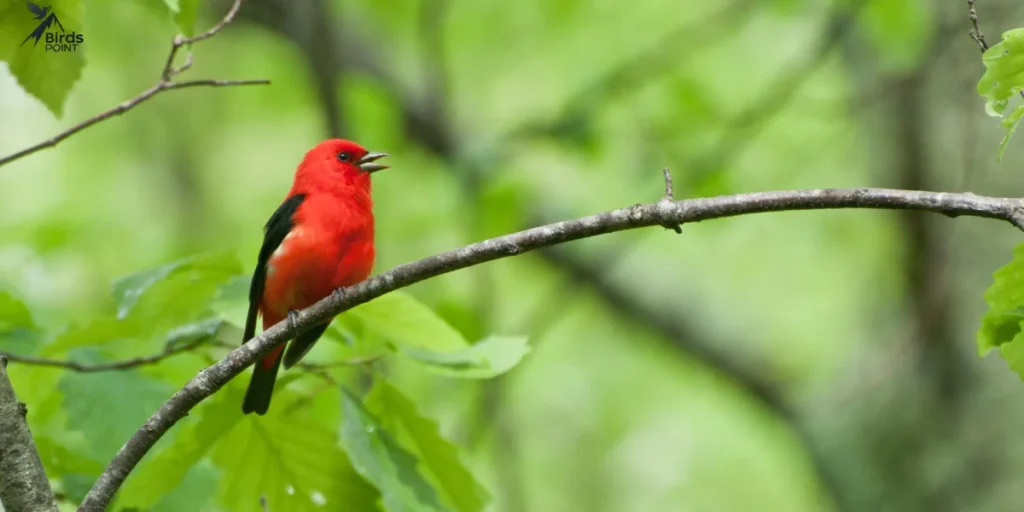
Habitat:
Scarlet Tanagers are found in the deciduous forests of the eastern United States, where they prefer to stay high in the canopy. They are often difficult to spot due to their preference for staying in the shadows of the leaves, but their song is a common sound in these forests.
Diet:
Scarlet Tanagers are omnivorous, feeding primarily on insects such as caterpillars, beetles, and wasps during the breeding season. They also eat a variety of fruits, particularly during migration and in their wintering grounds in South America.
Behavior and Migration:
Scarlet Tanagers are long-distance migrants, traveling from North America to their wintering grounds in the northern parts of South America, including countries like Colombia, Venezuela, and Ecuador. During migration, they often travel at night, covering great distances in a single flight. The male’s song is a series of short, burry phrases that are often compared to the sound of a robin with a sore throat.
Conservation Status:
The Scarlet Tanager is currently listed as Least Concern, but it faces challenges from habitat loss and fragmentation, particularly in its breeding and wintering grounds. Conservation efforts focus on preserving large tracts of forest and maintaining healthy ecosystems.
Cultural Significance:
The Scarlet Tanager is a symbol of the vibrant beauty of North America’s forests. Its striking color and elusive nature have made it a favorite among bird enthusiasts, who often go to great lengths to catch a glimpse of this stunning bird.
Interesting Fact:
Despite their bright colors, Scarlet Tanagers are masters of camouflage. When perched among the red and orange leaves of autumn trees, they can be surprisingly difficult to spot.
| Feature | Details |
|---|---|
| Scientific Name | Piranga olivacea |
| Lifespan | 6 to 12 years |
| Size | 6.3 to 7.5 inches (16 to 19 cm) |
| Wingspan | 9.8 to 11.4 inches (25 to 29 cm) |
| Weight | 0.8 to 1.3 ounces (24 to 37 grams) |
5. Spotted Towhee
Appearance:
The Spotted Towhee is a medium-sized songbird, around 7 to 8 inches in length, with a striking black body, orange sides, and a white belly. Its wings and back are spotted with white, giving it a distinctive appearance. The male and female look similar, although females may be slightly duller in color.

Habitat:
Spotted Towhees are commonly found in the western United States, particularly in shrubby areas, woodlands, and gardens. They prefer habitats with dense undergrowth where they can forage for food
on the ground. They are often seen scratching at the leaf litter with both feet, looking for insects and seeds.
Diet:
The diet of the Spotted Towhee includes a variety of insects, seeds, and fruits. They are ground foragers, often seen kicking up leaves and debris to uncover food. During the breeding season, they primarily eat insects, which provide the necessary protein for raising their young.
Behavior and Migration:
Spotted Towhees are generally non-migratory, although some populations in the northern part of their range may move to lower elevations or more southern areas during the winter. They are territorial birds, with males singing from prominent perches to defend their territory and attract mates. Their song is a fast, buzzing trill, often described as a “drink-your-tea” sound.
Conservation Status:
The Spotted Towhee is currently listed as Least Concern, with stable populations across its range. However, they face threats from habitat destruction and changes in land use, particularly in areas where their shrubby habitats are being replaced by development.
Cultural Significance:
The Spotted Towhee is a familiar bird to many people living in the western United States, where it is a common visitor to gardens and backyards. Its bold colors and distinctive behavior make it a favorite among birdwatchers and nature enthusiasts.
Interesting Fact:
Spotted Towhees are known for their “double-scratch” foraging technique, where they hop backward with both feet to uncover food in the leaf litter. This behavior is unique among birds and is a fun sight to observe.
| Feature | Details |
|---|---|
| Scientific Name | Pipilo maculatus |
| Lifespan | 5 to 9 years |
| Size | 7 to 8 inches (18 to 21 cm) |
| Wingspan | 10 to 11 inches (25 to 28 cm) |
| Weight | 1.2 to 1.7 ounces (33 to 4 |
6. Varied Thrush
Appearance:
The Varied Thrush is a medium-sized bird, around 7.5 to 10 inches in length, with a bright orange belly, black wings, and a black head. The bold, dark band across its chest gives it a striking appearance. Males and females look similar, although females may have slightly duller colors.
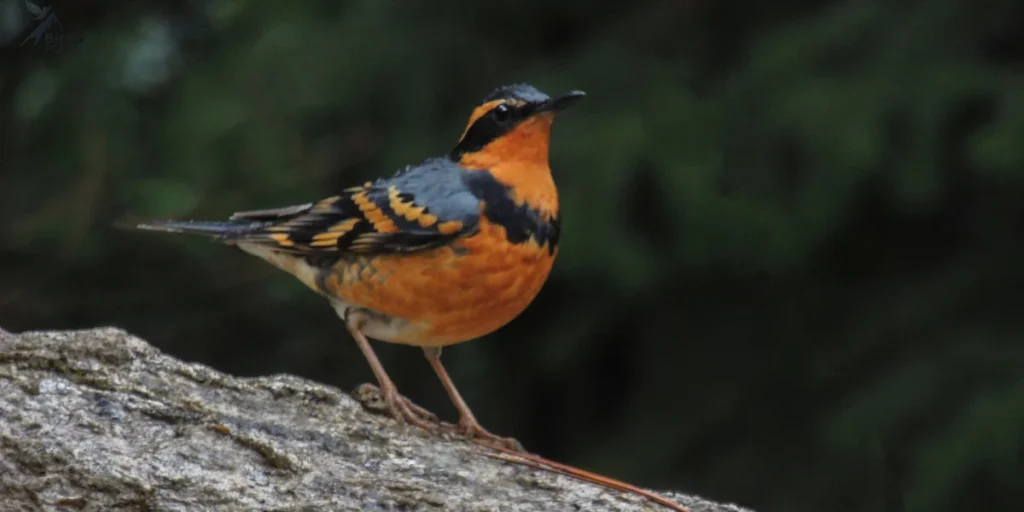
Habitat:
Varied Thrushes are primarily found in the Pacific Northwest of North America, where they inhabit moist forests, particularly those with dense undergrowth. They prefer to stay close to the ground, where they forage for food among the leaf litter.
Diet:
The diet of the Varied Thrush includes insects, berries, and seeds. During the winter, they rely more on berries and seeds, while in the summer, they consume more insects. They are ground foragers, often seen hopping along the forest floor, turning over leaves and debris in search of food.
Behavior and Migration:
Varied Thrushes are partially migratory, with populations in the northern part of their range moving to lower elevations or more southern areas during the winter. They are known for their clear, whistling song, which echoes through the forest and is often described as haunting or mysterious. Males sing from high perches to establish their territory and attract mates.
Conservation Status:
The Varied Thrush is currently listed as Least Concern, although its populations can fluctuate depending on food availability and habitat conditions. Conservation efforts focus on preserving the moist, forested habitats that these birds depend on for breeding and feeding.
Cultural Significance:
The Varied Thrush is often associated with the deep, quiet forests of the Pacific Northwest, where its haunting song can be heard echoing through the trees. It is a favorite among birdwatchers in the region and is often featured in nature photography and artwork.
Interesting Fact:
The Varied Thrush’s song is often compared to the sound of a distant flute or whistle, and it is one of the few bird songs that can be heard clearly through the dense forests where it lives.
| Feature | Details |
|---|---|
| Scientific Name | Ixoreus naevius |
| Lifespan | 4 to 7 years |
| Size | 7.5 to 10 inches (19 to 25.4 cm) |
| Wingspan | 13 to 15 inches (33 to 38 cm) |
| Weight | 2.3 to 3.5 ounces (65 to 100 grams) |
7. Eastern Towhee
Appearance:
The Eastern Towhee is a medium-sized bird, similar in size to the Spotted Towhee, with a black body, orange sides, and a white belly. Unlike the Spotted Towhee, the Eastern Towhee lacks the white spots on its wings. Males are more brightly colored, while females have brown upper parts instead of black.
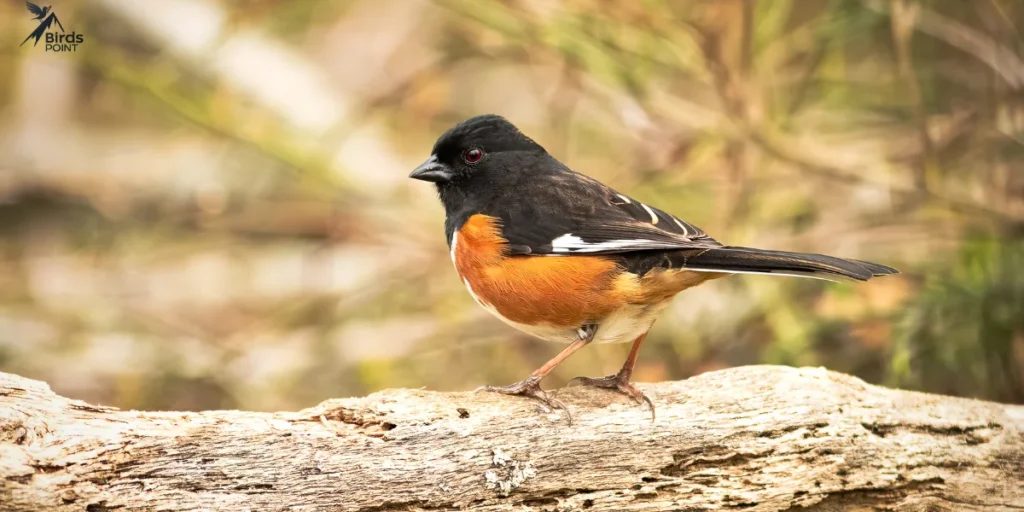
Habitat:
Eastern Towhees are found in the eastern United States, particularly in areas with dense shrubs and thickets. They are often seen on the ground, scratching in the leaf litter for food. They prefer habitats with a mix of open areas and dense cover, such as forest edges, overgrown fields, and gardens.
Diet:
The diet of the Eastern Towhee includes insects, seeds, and berries. Like the Spotted Towhee, they use a unique foraging method, scratching the ground with both feet to uncover food. During the breeding season, they eat more insects, which provide essential protein for raising their young.
Behavior and Migration:
Eastern Towhees are generally non-migratory, although northern populations may move to more southern areas during the winter. They are territorial birds, with males singing from prominent perches to defend their territory and attract mates. Their song is a clear “drink-your-tea” sound, often heard in the early morning.
Conservation Status:
The Eastern Towhee is currently listed as Least Concern, although some populations have declined due to habitat loss and changes in land use. Conservation efforts focus on preserving the shrubby habitats that these birds depend on for breeding and feeding.
Cultural Significance:
The Eastern Towhee is a familiar bird to many people living in the eastern United States, where it is a common visitor to gardens and backyards. Its bold colors and distinctive song make it a favorite among birdwatchers and nature enthusiasts.
Interesting Fact:
Eastern Towhees are known for their secretive behavior, often staying hidden in dense vegetation. However, their loud song and distinctive calls often give away their presence.
| Feature | Details |
|---|---|
| Scientific Name | Pipilo erythrophthalmus |
| Lifespan | 9 years |
| Size | 6.8 to 8.2 inches (17 to 21 cm) |
| Wingspan | 7.9 to 11 inches (20 to 28 cm) |
| Weight | 1 to 1.7 ounces (30 to 49 grams) |
8. Western Tanager
Appearance:
The Western Tanager is a medium-sized songbird, around 6.3 to 7.5 inches in length, with a bright orange-red head, black wings, and a yellow body. The male is more colorful than the female, which has duller colors with a more yellowish head and body. The bright coloration of the male is particularly vivid during the breeding season.

Habitat:
Western Tanagers are found in the western United States, from the forests of the Pacific Northwest to the deserts of the Southwest. They prefer to live in coniferous forests, particularly those with a mix of pine and fir trees. During migration, they can also be found in a variety of habitats, including gardens and urban areas.
Diet:
Western Tanagers are omnivorous, with a diet that includes insects, fruits, and berries. They are often seen catching insects in mid-air or foraging for berries in the trees. During the breeding season, they primarily feed on insects, while in the fall and winter, they switch to eating more fruits and berries.
Behavior and Migration:
Western Tanagers are migratory birds, spending the winter in Central America and northern South America. They travel long distances during migration, often crossing open desert and mountainous regions. Males are known for their distinctive song, a series of short, clear notes that are often compared to the song of a robin.
Conservation Status:
The Western Tanager is currently listed as Least Concern, with stable populations across its range. However, they face threats from habitat loss, particularly in their breeding and wintering grounds. Conservation efforts focus on preserving the coniferous forests that these birds depend on for breeding and feeding.
Cultural Significance:
The Western Tanager is a favorite among birdwatchers in the western United States, where its bright colors and distinctive song make it a highlight during birding events. It is also a symbol of the vibrant beauty of the western forests and mountains.
Interesting Fact:
Despite their bright colors, Western Tanagers are often difficult to spot because they spend much of their time high in the treetops. However, their distinctive song can often give away their presence.
| Feature | Details |
|---|---|
| Scientific Name | Piranga ludoviciana |
| Lifespan | 7 to 10 years |
| Size | 6.3 to 7.5 inches (16 to 19 cm) |
| Wingspan | 11.5 inches (29 cm) |
| Weight | 0.8 to 1.3 ounces (24 to 36 grams) |
9. Orchard Oriole (Male)
Appearance:
The male Orchard Oriole is a small songbird, around 5.9 to 7.1 inches in length, with a dark orange body and black head and back. The female is yellow-green with no black markings. The male’s bright coloration is particularly vivid during the breeding season, making him easy to spot.
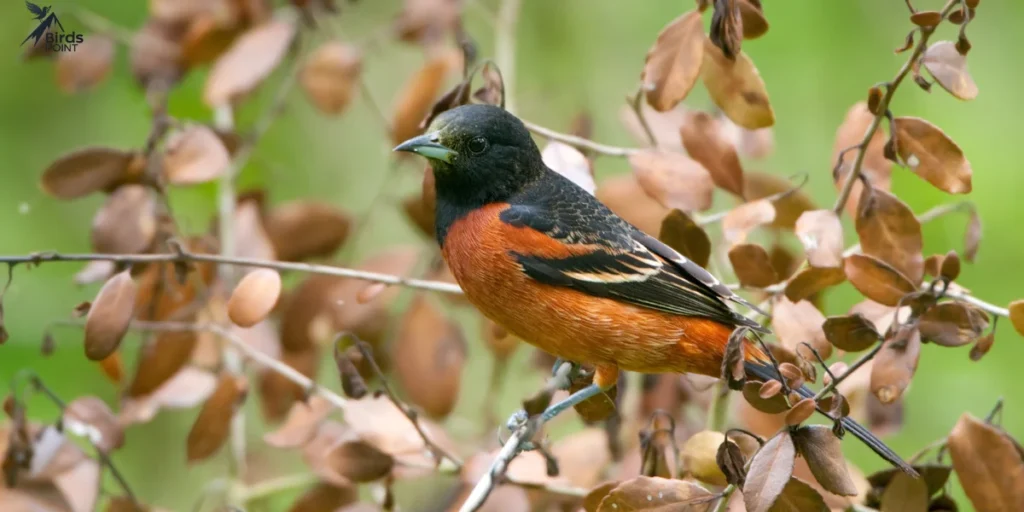
Habitat:
Orchard Orioles are found in the eastern and central United States, often in open woodlands, orchards, and gardens. They are especially common in areas with plenty of fruit trees, where they can find an abundant food supply. They build their nests in the branches of trees, often using plant fibers and grasses to create a hanging basket-like structure.
Diet:
Orchard Orioles are omnivorous, with a diet that includes insects, fruits, and nectar. They are known to visit hummingbird feeders to sip nectar and are also fond of eating berries and small fruits. During the breeding season, they primarily feed on insects, which provide essential protein for raising their young.
Behavior and Migration:
Orchard Orioles are migratory birds, spending the winter in Central America and northern South America. They often travel in small flocks during migration, and their journey is characterized by a series of short hops, stopping frequently to feed and rest. Males are known for their sweet, whistling songs, which they use to establish territories and attract mates.
Conservation Status:
The Orchard Oriole is currently listed as Least Concern, with stable populations across its range. However, they face threats from habitat loss, particularly in their breeding and wintering grounds. Conservation efforts focus on preserving the open woodlands and orchards that these birds depend on for breeding and feeding.
Cultural Significance:
The Orchard Oriole is a familiar bird to many people living in the eastern and central United States, where it is a common visitor to
gardens and orchards. Its sweet song and vibrant colors make it a favorite among birdwatchers and nature enthusiasts.
Interesting Fact:
Orchard Orioles are among the smallest orioles, but they are known for their powerful songs that fill the air in spring and summer. Their nests, which hang from tree branches, are also a marvel of avian engineering.
| Feature | Details |
|---|---|
| Scientific Name | Icterus spurius |
| Lifespan | 6 to 10 years |
| Size | 5.9 to 7.1 inches (15 to 18 cm) |
| Wingspan | 9.8 inches (25 cm) |
| Weight | 0.6 to 1 ounce (16 to 28 grams) |
10. Hooded Oriole
Appearance:
The Hooded Oriole is a medium-sized songbird, around 7.1 to 8.3 inches in length, with a bright orange-yellow body, black wings, and a black head. The male is particularly striking with his bold coloration, while the female is more yellowish in color with less contrasting markings.

Habitat:
Hooded Orioles are found in the southwestern United States, particularly in areas with palm trees, such as deserts and suburban gardens. They are often seen in areas with ornamental palms, where they build their nests in the leaves. These nests are woven from plant fibers and grass, creating a hanging basket that sways in the breeze.
Diet:
Hooded Orioles are omnivorous, with a diet that includes insects, fruits, and nectar. They are often seen visiting hummingbird feeders to drink the sweet nectar and are also fond of eating small fruits and berries. During the breeding season, they primarily feed on insects, which provide essential protein for raising their young.
Behavior and Migration:
Hooded Orioles are migratory birds, spending the winter in Mexico and Central America. They often travel in small flocks during migration, and their journey is characterized by a series of short hops, stopping frequently to feed and rest. Males are known for their sweet, whistling songs, which they use to establish territories and attract mates.
Conservation Status:
The Hooded Oriole is currently listed as Least Concern, with stable populations across its range. However, they face threats from habitat loss, particularly in their breeding and wintering grounds. Conservation efforts focus on preserving the palm trees and other habitats that these birds depend on for breeding and feeding.
Cultural Significance:
The Hooded Oriole is sometimes called the “palm-leaf oriole” because of its habit of nesting in palm trees. It is a familiar bird to many people living in the southwestern United States, where it is a common visitor to gardens and parks. Its sweet song and vibrant colors make it a favorite among birdwatchers and nature enthusiasts.
Interesting Fact:
Hooded Orioles are known for their adaptability, often thriving in suburban areas where they find plenty of palm trees and other ornamental plants to build their nests. They are also known for their curious behavior, often investigating new objects or changes in their environment.
| Feature | Details |
|---|---|
| Scientific Name | Icterus cucullatus |
| Lifespan | 6 to 9 years |
| Size | 7.1 to 8.3 inches (18 to 21 cm) |
| Wingspan | 9.8 to 11 inches (25 to 28 cm) |
| Weight | 0.7 to 1 ounce (20 to 28 grams) |
Conclusion
These ten black and orange birds are not only beautiful but also fascinating creatures with unique habits, songs, and stories. From the bright Baltimore Oriole to the striking Hooded Oriole, each bird has its own charm and character. Whether you’re a birdwatcher or just someone who enjoys nature, spotting one of these colorful birds is always a delightful experience. The vibrant colors of these birds serve various purposes, from attracting mates to deterring predators, and their songs add a melodious backdrop to the natural world. As you explore the outdoors, keep your eyes and ears open—you might just encounter one of these amazing birds on your next adventure!
FAQs
Q: What is the most common black and orange bird in North America?
A: The Baltimore Oriole is one of the most common and easily recognized black and orange birds in North America.
Q: Are black and orange birds rare?
A: Black and orange birds are not necessarily rare, but their visibility can depend on their habitat and migration patterns. Species like the Baltimore Oriole and American Redstart are relatively common in their respective ranges.
Q: What do black and orange birds eat?
A: Most black and orange birds have varied diets, typically including insects, fruits, and nectar. Their diet can change with the seasons and during migration.
Q: Do black and orange birds migrate?
A: Yes, many black and orange birds, such as the Baltimore Oriole and Scarlet Tanager, are migratory, traveling between their breeding grounds in North America and their wintering grounds in Central and South America.
Q: How can I attract black and orange birds to my yard?
A: You can attract black and orange birds like Baltimore Orioles by offering fruits (especially oranges), nectar, and suet. Providing a habitat with trees and shrubs will also make your yard more inviting.
Q: Why are some birds black and orange?
A: The black and orange coloration in birds often plays a role in mating and territorial displays. Bright colors can attract mates and also serve as a warning to predators.
Q: Which black and orange bird is known for its distinctive song?
A: The Scarlet Tanager is known for its sweet, melodious song, which is often compared to the song of a robin but with a slightly rougher tone.

1 thought on “10 Stunning Black and Orange Birds: Species & Photos”